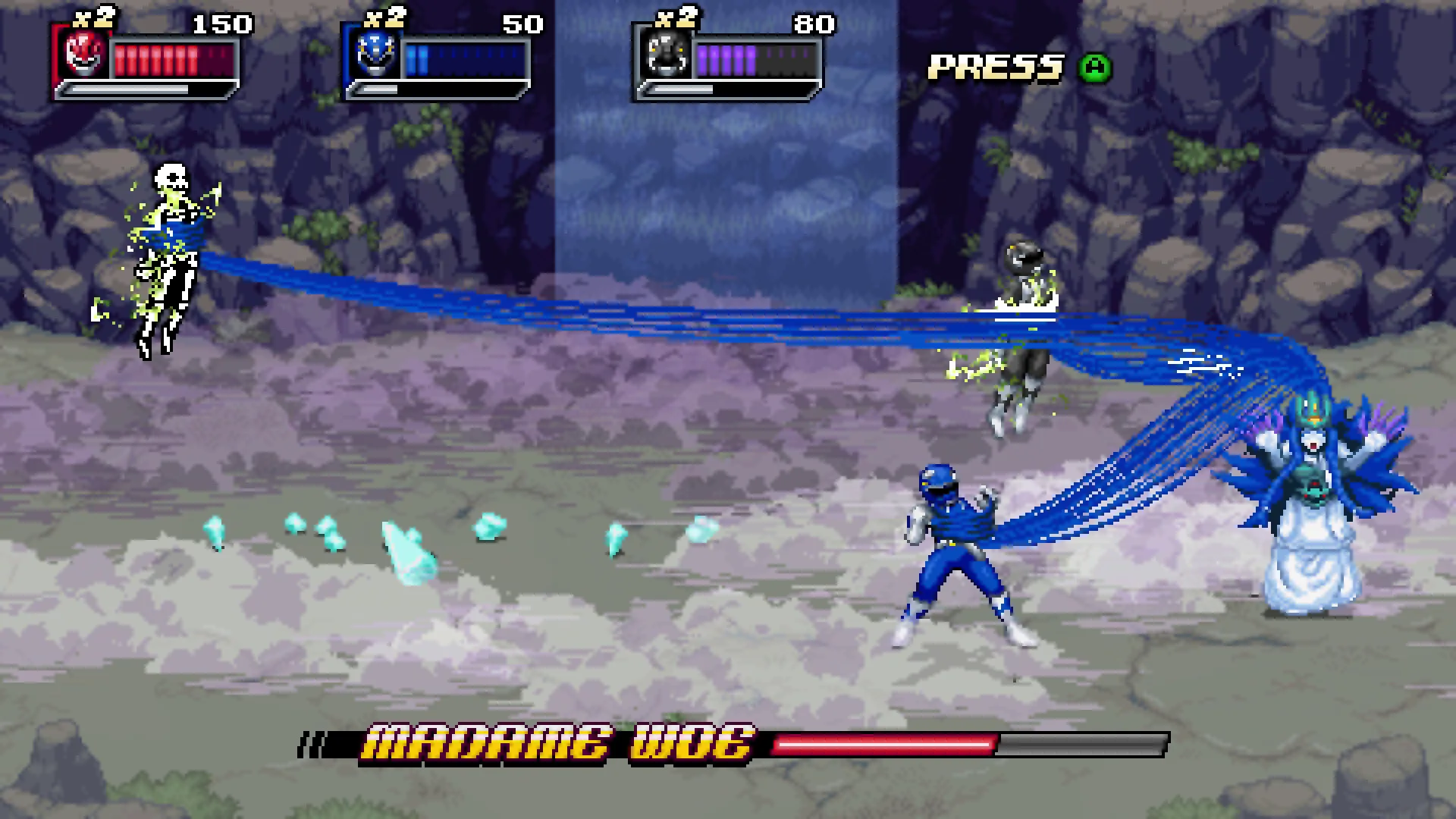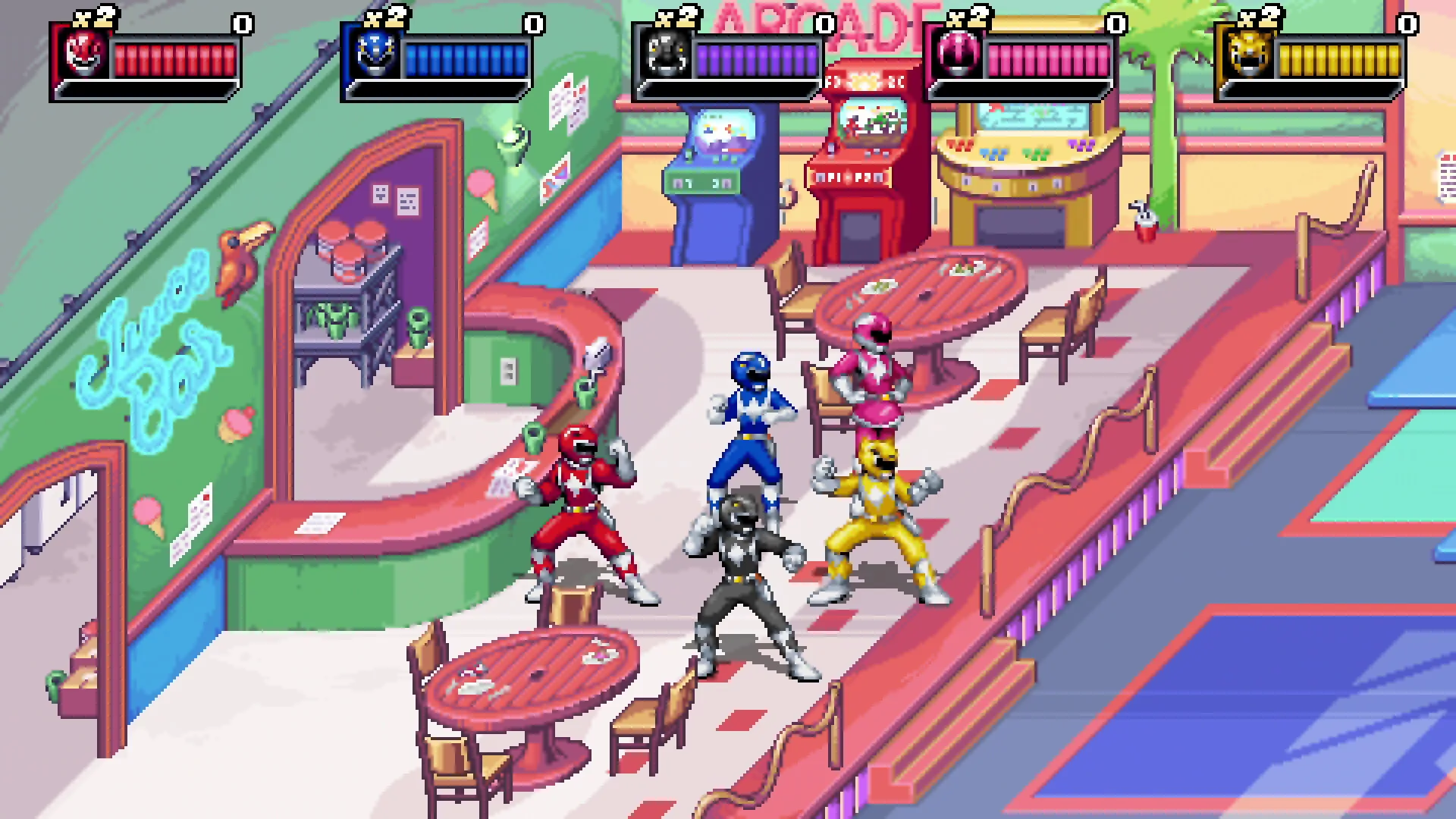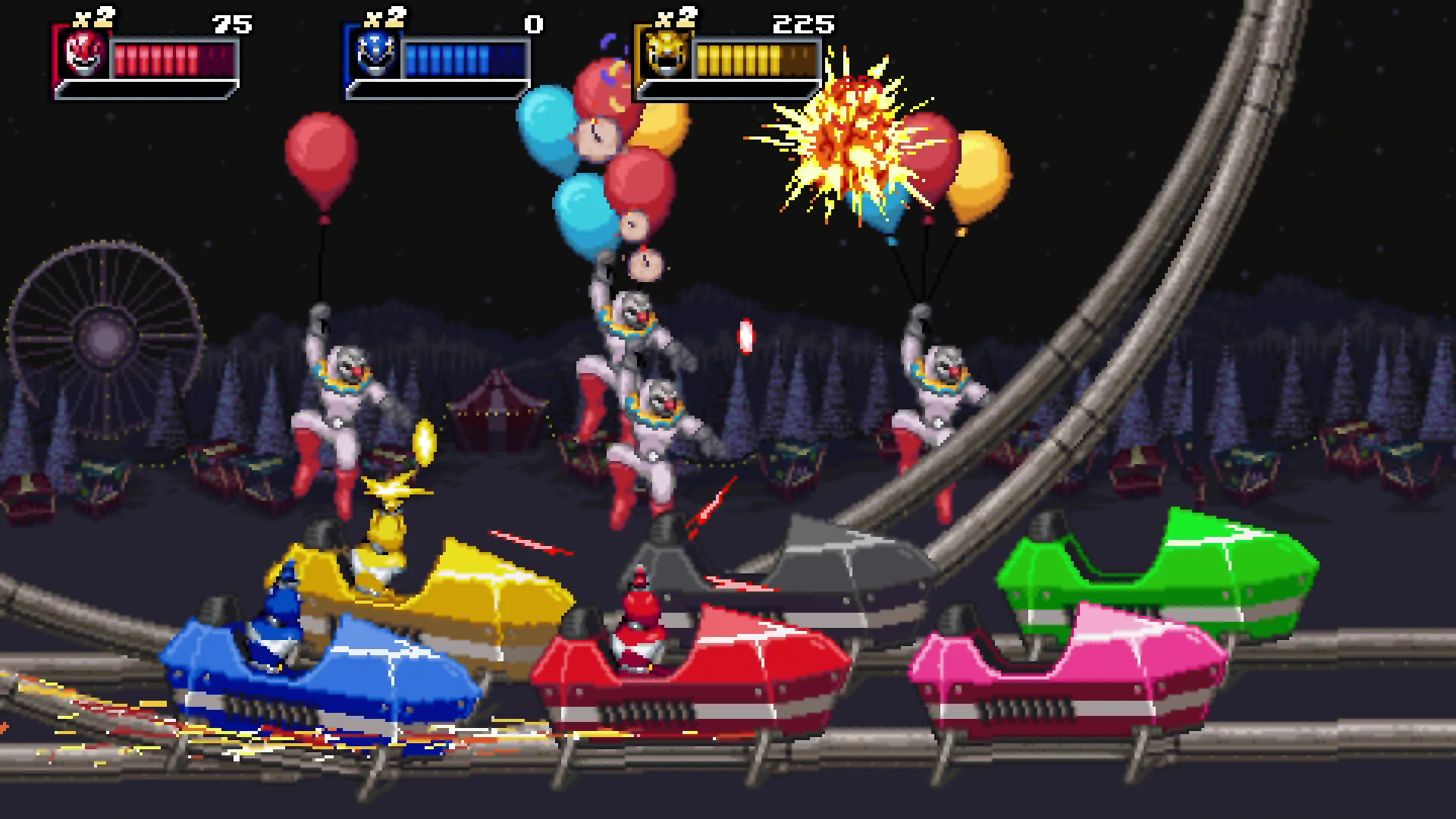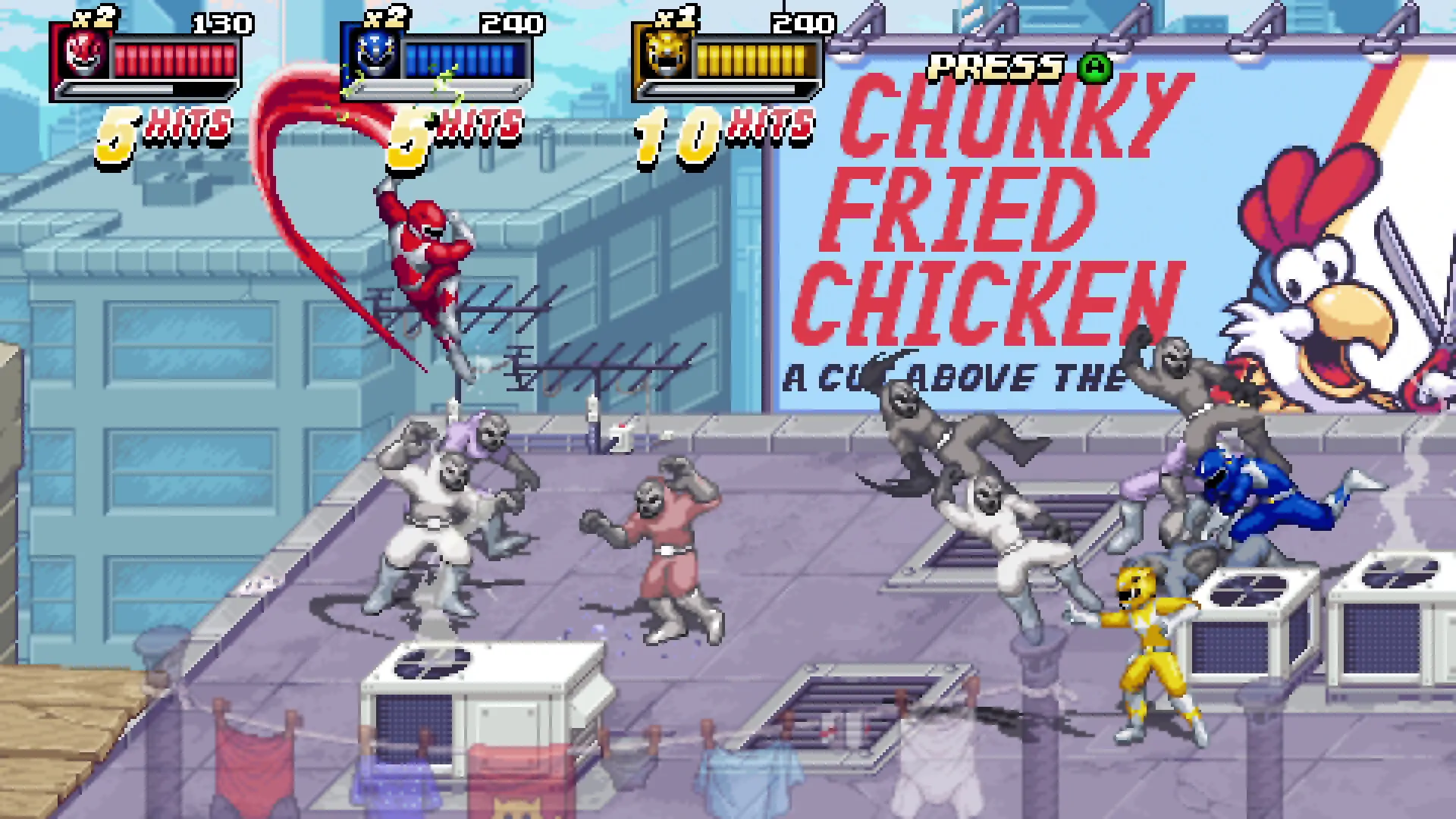Mighty Morphin Power Rangers: Rita’s Rewind is a fun tribute to the popular franchise, blending old-school charm with new-school gameplay mechanics. This game was made by Digital Eclipse, a company known for bringing old games back to life. It tries to capture the joy of arcade brawlers from the 1990s while adding new elements that will resonate with new players and fans alike.
Players must handle a straightforward but engaging narrative that centers on Robo Rita’s plan to change the past against a backdrop of time-traveling chaos. In addition to combat, character interactions that incorporate humor and familiarity into the gameplay are made possible by this premise. The choice of playable Rangers, each with their combat techniques, enhances player agency.
For example, the Yellow Ranger may need more skill because she has a shorter range, while the Red Ranger’s ability to handle crowds makes for different strategies. This design choice successfully reflects the overall theme of teamwork and personal strengths that the Power Rangers franchise embodies.
Time-Traveling Nostalgia: A Narrative Rewind
The story of Mighty Morphin Power Rangers: Rita’s Rewind is based on the time travel plot device, which is both fun and straightforward. The characters are sucked into a plan by Robo Rita, who teams up with her past self to get rid of the Power Rangers.
This setup is a way to go on adventures and cleverly ties together different parts of the franchise’s history. The original Rangers are portrayed in a new and familiar role thanks to the narrative idea that encourages players to revisit famous moments.
The game does a good job of appealing to nostalgia by taking players back to the silly charm of the 90s series. As with the show, the episodic structure allows for short bursts of action reminiscent of the series’ famous fights against familiar enemies. This design choice enhances emotional impact, allowing fans to relive their best moments and newcomers to enjoy the lively storytelling without knowing much about the subject.
The game’s graphics and music also convey a real sense of authenticity, strengthening its link to the beloved source. The vibrant soundtrack complements the gameplay, creating an immersive atmosphere, and the colorful pixel art captures the essence of the original series. Ultimately, the narrative and nostalgic elements work well together, inviting players to engage in a world that feels both nostalgic and current, striking a balance that appeals to a wide range of players.
Combat and Chaos: Mechanics That Matter
Rita’s Rewind is a standard beat ’em up game that offers players a straightforward yet engaging combat system that feels familiar to fans of the genre. The basic controls include various jump and dodge options, along with a normal attack combo and a throw mechanic for close combat.
This ease of use makes it accessible, so new and experienced players can jump right into the action. However, the game shines when players experiment with moves that are special to each Ranger. Each Ranger has their own set of skills, which encourages players to use a variety of play styles and make strategic choices.
The most notable aspects of the gameplay are time disruptors, mechanical devices that increase the complexity of combat encounters. When players engage with these disruptors, they must balance the immediate threat of swarming enemies and the urgent need to destroy the device before it returns and restarts the battle.
This feature enriches the combat experience and ties into the narrative’s time travel theme, creating a sense of urgency and weight. The ability to control the flow of battle by controlling the disruptors adds depth and encourages players to consider their actions critically.
The game uses classic beat ’em up mechanics, but it also has some similarities to more recent indie games experimenting with combat systems, like Streets of Rage 4. In contrast to those games, Rita’s Rewind stays true to its nostalgic roots, providing a simpler but enjoyable combat experience. The result is a system that honors the genre’s history while providing enough original elements to keep players interested and invested in their choices. It all fits perfectly with the vibrant tapestry of the Power Rangers universe.
Aesthetic Appeal: Crafting Nostalgia Through Visuals and Sound
The pixel art style in Mighty Morphin Power Rangers: Rita’s Rewind is a tribute to retro style, perfectly capturing the lively energy of the original series. The hand-drawn sprites are not only bright and expressive, but they are also full of small details that will resonate with die-hard fans.
While utilizing modern techniques to improve clarity and nostalgia, this visual design evokes a sense of nostalgia and is reminiscent of the classic arcade games of the 1990s. Adding a CRT filter makes it look even more retro, like old monitors, and makes players feel like they’re in a time capsule of gaming history. Rita’s Rewind strikes a balance, ensuring that the graphics stay clear and engaging, unlike some retro-inspired games that may rely too much on these filters.
The beautiful visuals are paired with a lively soundtrack that captures the essence of the Power Ranger’s history. The music, which features catchy melodies and energetic guitar riffs, enhances the emotional stakes during combat and matches the fast-paced gameplay. Voice acting with familiar tones that bring back the spirit of the original characters makes the sound design even better. The lively and engaging performances add humor and personality to the narrative. This attention to auditory detail enriches the gameplay experience and creates a cohesive atmosphere that resonates with both nostalgic fans and newcomers alike.
The interplay between the art style and soundtrack reinforces the game’s narrative, weaving together a sensory experience that immerses players in the Power Rangers’ world while highlighting the emotional core of their heroic escapades.
Rangers Unite: Combat Diversity and Challenge
Mighty Morphin Power Rangers: Rita’s Rewind excels in character differentiation, presenting each Ranger with unique abilities that shape their gameplay style. The Red Ranger, for instance, wields a sword that allows for effective crowd control, while the Pink Ranger’s aerial abilities enable her to navigate combat zones with grace.
This diversity encourages players to experiment with different characters and fosters a sense of camaraderie and strategy as players must consider their team composition to tackle various challenges. The inherent strengths and weaknesses of each Ranger create a dynamic layer of choice, ensuring that players feel an emotional investment in their selection, reminiscent of RPGs where character choice significantly impacts gameplay.
The game’s enemy variety further enhances this combat experience. Players encounter a range of foes, from the familiar Putties to the more formidable Tenga Warriors, each requiring different tactics to defeat. This variety keeps battles engaging, as players must adapt their strategies based on the enemy type—dodging, countering, or employing special moves.
Boss fights are particularly noteworthy, featuring iconic villains from the franchise that offer unique mechanics and challenges. For example, a showdown with a fan-favorite monster might involve not just brute force but also environmental awareness and timing, echoing the strategic depth found in modern indie games.
This blend of character abilities and enemy diversity creates a layered combat system that is accessible yet rich in complexity. Players are encouraged to find their rhythm and develop strategies that resonate with their playstyle, leading to memorable moments that align with the series’ overarching themes of teamwork and individual growth.
Level Dynamics: Crafting Engagement Through Design
Power Rangers: Rita’s Rewind, level design plays a crucial role in maintaining player engagement and enhancing the overarching narrative. The game features various levels that blend traditional brawling segments with unique Zord sequences.
Players transition from fighting hordes of Putties in vibrant urban environments to piloting their Zords in fast-paced, pseudo-3D segments reminiscent of classic arcade shooters. This variety keeps the gameplay fresh and aligns with the thematic elements of the Power Rangers universe, where teamwork and adaptability are paramount.
The Zord segments, while visually impressive, can elicit mixed responses due to their pacing and challenge. Players often find themselves navigating intense sequences that require quick reflexes and strategic dodging, echoing the high-stakes action of the show. However, some segments present difficulty spikes that may frustrate players, particularly in co-op modes where coordination becomes essential. The balance between brawling and Zord gameplay creates a rhythm that encourages players to switch gears, though inconsistency in challenge levels can disrupt the flow.
Overall, the level structure is designed to evoke nostalgia while introducing modern gameplay elements. Each level feels distinct, with environmental hazards and enemy placements encouraging exploration and strategy. Yet, there are moments when the pacing feels uneven, particularly during transitions between combat types.
Players may find themselves adjusting to different difficulty levels, leading to moments of frustration rather than fun. While trying for a dynamic experience, this design choice sometimes detracts from the overall enjoyment, especially for those who may not be as familiar with the genre.
Ultimately, Rita’s Rewind demonstrates a commendable effort to merge narrative and gameplay through its level design, inviting players to experience the thrill of being a Power Ranger while navigating the challenges that come with it.
Teamwork and Beyond: Exploring Multiplayer Dynamics
Mighty Morphin Power Rangers: Rita’s Rewind embraces the spirit of teamwork through its local multiplayer options, allowing players to join forces as they tackle the game’s vibrant levels together. The cooperative gameplay is intuitive, with each Ranger’s unique skills complementing one another, creating a sense of camaraderie reminiscent of the show.
While currently focused on local co-op, the promise of future online multiplayer features could elevate the experience, making it accessible to a wider audience and enhancing the social aspect of gameplay. This focus on collaboration aligns exactly with the Power Rangers ethos and enriches the overall gameplay, encouraging strategic coordination.
Replayability is another highlight, driven by a wealth of collectibles and unlockable content that beckons players to return after finishing the main story. Hidden items scattered throughout levels encourage thorough exploration, rewarding players who engage with the surroundings.
Completing levels with different Rangers reveals unique interactions and character-specific challenges, further incentivizing multiple playthroughs. The game also adds post-game challenges that test players’ mastery of combat mechanics, successfully extending the lifespan of the experience beyond the initial run.
Comparatively, this method mirrors titles like Streets of Rage 4, emphasizing cooperative play and replayability through unlockables. However, Rita’s Rewind leans more heavily into its nostalgic roots, providing a less punishing yet satisfying experience that balances accessibility with depth. Whether reliving the game alone or with friends, players can always find joy thanks to this blend of cooperative mechanics and replayable content.
The Review
Mighty Morphin Power Rangers: Rita's Rewind
Mighty Morphin Power Rangers: Rita's Rewind successfully captures the franchise's nostalgic essence while offering engaging gameplay and flexible character powers. Although some pacing problems and difficulty spikes can detract from the overall experience, its cooperative mechanics make it more fun. The bright graphics and catchy music make players feel even more like they are in this beloved world. Its wealth of collectibles and replayable content encourages casual and die-hard fans to return for more.
PROS
- Engaging cooperative gameplay enhances the experience.
- Unique character abilities promote varied playstyles.
- Nostalgic visuals and a vibrant soundtrack.
- Abundant collectibles and replayable content.
CONS
- Some pacing issues and difficulty spikes.
- Limited online multiplayer features at launch.
- Occasional uneven challenge levels.





















































